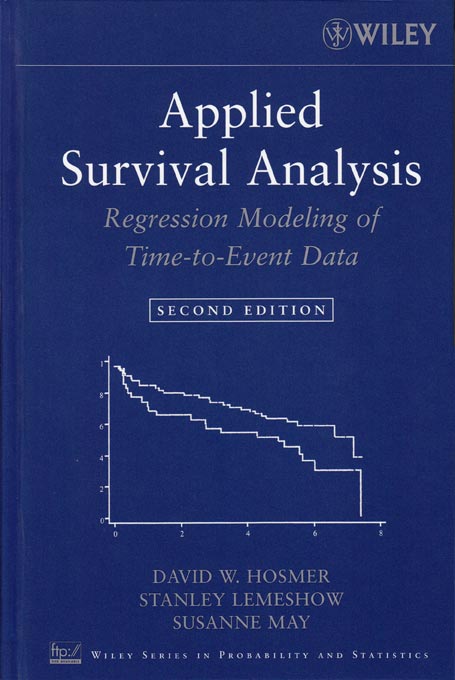

Applied Survival Analysis: Regression Modeling of Time to Event Data, Second Edition |
||||||||||||||||||||||||||||||||||||||
 Click to enlarge See the back cover |

As an Amazon Associate, StataCorp earns a small referral credit from
qualifying purchases made from affiliate links on our site.
eBook not available for this title
eBook not available for this title |
|
||||||||||||||||||||||||||||||||||||
Comment from the Stata technical groupApplied Survival Analysis: Regression Modeling of Time to Event Data, Second Edition, by David W. Hosmer Jr., Stanley Lemeshow, and Susanne May, is an ideal choice for a semester-long course in survival analysis for health professionals. The authors provide a good overview of regression models for time-to-event data, giving the most depth to the Cox proportional hazards model. Unlike similar texts, Applied Survival Analysis is not overly abstract or mathematical in its introduction of the concepts of survival analysis, but it instead relies on a model-building approach. As such, this text is most useful to those who are experienced in using regression models in nonsurvival settings, such as Gaussian or logistic regression. The text builds upon the reader's prior experience by showing how the usual techniques of regression and model building apply to survival data. The text illustrates most of its analyses in Stata, and material added since the first edition mirrors Stata's growth in survival analysis, for example, the new material on multivariable fractional polynomials and frailty models. The authors cover such topics as censoring; descriptive methods such as Kaplan–Meier; the Cox model (including estimation, model building, diagnostics, and extensions); parametric regression models (an introductory chapter); and some advanced topics, such as recurrent event models and competing risks. |
||||||||||||||||||||||||||||||||||||||
Table of contentsView table of contents >> Preface
1. Introduction to Regression Modeling of Survival Data
1.1 Introduction
1.2 Typical Censoring Mechanisms 1.3 Example Data Sets Exercises 2. Descriptive Methods for Survival Data
2.1 Introduction
2.2 Estimating the Survival Function 2.3 Using the Estimated Survival Function 2.4 Comparison of Survival Functions 2.5 Other Functions of Survival Time and Their Estimators Exercises 3. Regression Models for Survival Data
3.1 Introduction
3.2 Semi-Parametric Regression Models 3.3 Fitting the Proportional Hazards Regression Model 3.4 Fitting the Proportional Hazards Model with Tied Survival Times 3.5 Estimating the Survival Function of the Proportional Hazards Regression Model Exercises 4. Interpretation of a Fitted Proportional Hazards Regression Model
4.1 Introduction
4.2 Nominal Scale Covariate 4.3 Continuous Scale Covariate 4.4 Multiple-Covariate Models 4.5 Interpretating and Using the Estimated Covariate-Adjusted Survival Function Exercises 5. Model Development
5.1 Introduction
5.2 Purposeful Selection of Covariates
5.2.1 Methods to examine the scale of continuous covariates in the log hazard
5.3 Stepwise, Best-Subsets and Multivariable Fractional Polynomial Methods of Selecting Covariates 5.2.2 An example of purposeful selection of covariates
5.3.1 Stepwise selection of covariates
5.4 Numerical Problems 5.3.2 Best subsets selection of covariates 5.3.3 Selecting covariates and checking their scale using multivariable fractional polynomials Exercises 6. Assessment of Model Adequacy
6.1 Introduction
6.2 Residuals 6.3 Assessing the Proportional Hazards Assumption 6.4 Identification of Influential and Poorly Fit Subjects 6.5 Assessing Overall Goodness-of-Fit 6.6 Interpretating and Presentating Results From the Final Model Exercises 7. Extensions of the Proportional Hazards Model
7.1 Introduction
7.2 The Stratified Proportional Hazards Model 7.3 Time-Varying Covariates 7.4 Truncated, Left Censored, and Interval Censored Data Exercises 8. Parametric Regression Models
8.1 Introduction
8.2 The Exponential Regression Model 8.3 The Weibull Regression Model 8.4 The Log-Logistic Regression Model 8.5 Other Parametric Regression Models Exercises 9. Other Models and Topics
9.1 Introduction
9.2 Recurrent Event Models 9.3 Frailty Models 9.4 Nested Case–Control Studies 9.5 Additive Models 9.6 Competing Risk Models 9.7 Sample Size and Power 9.8 Missing Data Exercises Appendix 1 The Delta Method
Appendix 2 An Introduction to the Counting Process Approach to Survival Analysis
Appendix 3 Percentiles for Computation of the Hall and Wellner Confidence Band
References
Index
|
||||||||||||||||||||||||||||||||||||||
Learn
Free webinars
NetCourses
Classroom and web training
Organizational training
Video tutorials
Third-party courses
Web resources
Teaching with Stata
© Copyright 1996–2025 StataCorp LLC. All rights reserved.
×
We use cookies to ensure that we give you the best experience on our website—to enhance site navigation, to analyze usage, and to assist in our marketing efforts. By continuing to use our site, you consent to the storing of cookies on your device and agree to delivery of content, including web fonts and JavaScript, from third party web services.
Cookie Settings
Last updated: 16 November 2022
StataCorp LLC (StataCorp) strives to provide our users with exceptional products and services. To do so, we must collect personal information from you. This information is necessary to conduct business with our existing and potential customers. We collect and use this information only where we may legally do so. This policy explains what personal information we collect, how we use it, and what rights you have to that information.
These cookies are essential for our website to function and do not store any personally identifiable information. These cookies cannot be disabled.
This website uses cookies to provide you with a better user experience. A cookie is a small piece of data our website stores on a site visitor's hard drive and accesses each time you visit so we can improve your access to our site, better understand how you use our site, and serve you content that may be of interest to you. For instance, we store a cookie when you log in to our shopping cart so that we can maintain your shopping cart should you not complete checkout. These cookies do not directly store your personal information, but they do support the ability to uniquely identify your internet browser and device.
Please note: Clearing your browser cookies at any time will undo preferences saved here. The option selected here will apply only to the device you are currently using.